Lovingly referred to as the “Sunshine Vitamin,” vitamin D is just as important as any other essential nutrient that our body needs to maintain optimal health.
In fact, vitamin D isn’t a mere “vitamin” at all. It’s a steroidal prohormone, which when converted in the body, is chartered with the paltry task of widespread DNA expression in every cell of our body!
No biggie, right?
Science still has yet to identify just how many jobs this prohormone has in the body, but they have found out enough facts to know that the body can’t survive without it and when levels become low, health can suffer in any number of different ways.
Scary statistics have been emerging over the last decade, with countries all over the world developing dangerous deficiencies: North America, Europe, the UK, India, and even Australia. While 40% of Americans have a vitamin D deficiency, the Indian population is currently the most at risk, with estimates of 70% – 100% of all its citizens being seriously deficient in this life-giving vitamin.
Top 10 Vitamin D Supplements
| Brand | Overall Rating | Serving Size | Price/ Serving | Effectiveness | Quality | Taste | Digestibility | |
#1 View View |
Now Foods | 5 / 5 | 1 Softgel | $0.05 | 5 / 5 | 5 / 5 | 5 / 5 | 5 / 5 |
#2 View View |
Vita Optimum | 5 / 5 | 1 Softgel | $0.04 | 5 / 5 | 5 / 5 | 5 / 5 | 5 / 5 |
#3 View View |
Nutrigold | 4.9 / 5 | 1 Softgel | $0.06 | 4.9 / 5 | 4.8 / 5 | 4.8 / 5 | 4.8 / 5 |
#4 View View |
NatureWise | 4.8 / 5 | 1 Softgel | $0.04 | 4.7 / 5 | 4.7 / 5 | 4.7 / 5 | 4.7 / 5 |
#5 View View |
Vitafusion | 4.6 / 5 | 2 Softgels | $0.06 | 4.5 / 5 | 4.7 / 5 | 4.6 / 5 | 4.5 / 5 |
| Brand | Overall Rating | Serving Size | Price/ Serving | Effectiveness | Quality | Taste | Digestibility | |
#6 View View |
Nature Made | 4.5 / 5 | 1 Softgel | $0.08 | 4.5 / 5 | 4.4 / 5 | 4.4 / 5 | 4.4 / 5 |
#7 View View |
Kirkland | 4.2 / 5 | 1 Softgel | $0.02 | 4.0 / 5 | 4.2 / 5 | 4.0 / 5 | 4.1 / 5 |
#8 View View |
Seeking Health – Best Vitamin D Drops | 5 / 5 | 1 Drop | $0.03 | 5 / 5 | 5 / 5 | 5 / 5 | 5 / 5 |
#9 View View |
D Drops Best Baby Drops | 5 / 5 | 1 Drop | $0.18 | 5 / 5 | 5 / 5 | 5 / 5 | 5 / 5 |
#10 View View |
Karlson Labs | 4.9 / 5 | 1 Drop | $0.03 | 4.8 / 5 | 4.8 / 5 | 4.8 / 5 | 4.8 / 5 |
What is Vitamin D?
 Vitamin D is a fat-soluble vitamin. You’ll find that most quality supplements will include olive or some other kind of fatty plant oil in their products to increase absorbtion. The fact that it’s fat-soluble has another bonus for human beings, since our body fat can hold on to it and store it for later use. Unlike other essentials like C and B-complex vitamins which cannot be stored for very long in the body.(1)
Vitamin D is a fat-soluble vitamin. You’ll find that most quality supplements will include olive or some other kind of fatty plant oil in their products to increase absorbtion. The fact that it’s fat-soluble has another bonus for human beings, since our body fat can hold on to it and store it for later use. Unlike other essentials like C and B-complex vitamins which cannot be stored for very long in the body.(1)
Most important, when “D” is converted in the kidneys to calcitriol, it then becomes responsible for turning over 200 genes on and off in the body as needed. Just a few that might interest you include: the immune system, bone growth and repair, and optimizing the digestion of minerals in the gut.(2)
Nearly every single animal on the planet is capable of making vitamin D on their own, without the need for sunshine or bioavailable “D” in their diet. Humans are not.
3 Ways We Get Vitamin D
1. Sunshine
 This is by far the easiest way to get vitamin D. UVB rays from the sun are absorbed by a special cholesterol called provitamin D3 in our skin. Just 10 minutes of midday sun exposure, when wearing shorts and a t-shirt, gives us 10,000 IU (the recommended daily dose for adults is 600 IU.) The end result produces “D” in its active, ready-to-convert form “D3”.(3)
This is by far the easiest way to get vitamin D. UVB rays from the sun are absorbed by a special cholesterol called provitamin D3 in our skin. Just 10 minutes of midday sun exposure, when wearing shorts and a t-shirt, gives us 10,000 IU (the recommended daily dose for adults is 600 IU.) The end result produces “D” in its active, ready-to-convert form “D3”.(3)
Dark-skinned people don’t absorb as much vitamin D because of the UV protective melanin in their skin.
This is also true for caucasians who get lots of sun and a deep tan; meaning more sun doesn’t necessarily equate to more vitamin D.
2. Vitamin D3 (Cholecalciferol)
Some fatty foods like eggs and fatty fish have small amounts of D3 (called “cholecalciferol” in medical-speak.) This is the active form of vitamin D that’s most easily absorbed from dietary sources. Some grain and dairy products are fortified with D3, but only in small amounts. Vitamin D3 is what you’re looking for on the label of supplements, as it’s an indication that the manufacturer isn’t cheaping out on the ingredients.(4)
3. Vitamin D2 (Ergocalciferol):
Vitamin D2 (“ergocalciferol”) is also found in fortified foods. Some mushroom varieties also have low levels of D2, but not much. While cholecalciferol (D3) is ready for the body to use, ergocalciferol (D2) isn’t. It needs to be converted by the liver first in order to become D3. (5)
Important Note:
Vitamin D3 is two times more likely to be absorbed in the body (source).
What Does the Body Use it For?
Once vitamin D3 is converted to calcitriol, it takes on numerous jobs. As mentioned earlier, so many jobs that science has yet to identify all of them.
Nearly every genetic cell in the human body has receptors called “Vitamin D Receptors” (“VDR” for short). These receptors respond to calcitriol when it comes in contact with them, turning them on or off. This includes the white blood cells in our immune system, as well as its gut-related tasks.
Vitamin D and the Gut Connection:
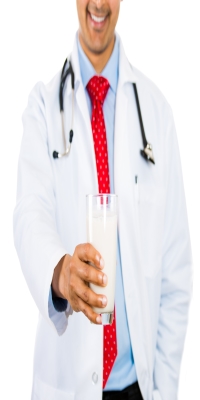 This magical prohormone tells our gut when to absorb calcium, phosphorous, magnesium and iron when levels become low in the body. Essentially, calcitriol regulates many of the essential minerals our body needs to maintain health.
This magical prohormone tells our gut when to absorb calcium, phosphorous, magnesium and iron when levels become low in the body. Essentially, calcitriol regulates many of the essential minerals our body needs to maintain health.
Calcitriol prevents us from getting too much of these nutrients. Unfortunately, when we don’t get enough vitamin D in our diet, the gut doesn’t get those signals it needs, leading to wide-spread nutritional deficiencies and causing:(6)
• Osteoporosis and other bone deficiencies.
• Heart disease.
• Autoimmunity.
• Increased illness (eg., cold and flu.)
• Cancer.
• Depression.
• Dementia and other degenerative mental conditions.
• Respiratory problems.
How Much You Should be Getting Every Day
• Infants (under 1 year): 400 IU
• Toddlers, Children and Adults (up to 50 years): 600 IU
• Pregnant and Breast-Feeding Mothers: 800 IU
• Middle-Aged and Elderly (over 50 years): 800 IU
Natural Sources of Vitamin D
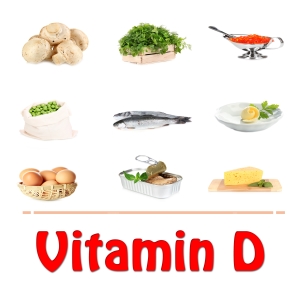 Cod liver oil, salmon and fresh-caught tuna are the only real significant sources of vitamin D found in nature. Eggs have some also, but you’d have to eat two dozen of them per day to reach the RDA. (7)
Cod liver oil, salmon and fresh-caught tuna are the only real significant sources of vitamin D found in nature. Eggs have some also, but you’d have to eat two dozen of them per day to reach the RDA. (7)
• Cod liver oil (1 tsp): 1360 IU
• 3-Ounces of Salmon: 447 IU
• 3-Ounces of Fresh tuna : 254 IU
• 1 Large Egg Yolk : 42 IU
What Happens When You Don’t Get Enough Vitamin D?
1.Osteoporosis
Calcitriol, the active hormone that vitamin D becomes after it’s converted by the kidneys, is needed to pull dietary calcium from the gut into the blood, where the calcium is then transported where it’s needed. Our bones use the majority of the calcium we take in. Calcitriol also allows the body to pull calcium from our bones as needed, at times when we aren’t consuming enough, to replenish and repair injured or calcium-depleted bones (as well as weakened teeth.)(8)
2.Weakened Immune System
Vitamin D helps the immune system react to foreign invaders in the body. It’s also essential for helping to dampen the immune response once the threat’s been destroyed. Low vitamin D has been linked to many sicknesses like the flu, common cold, tuberculosis, and influenza.(9)
3.Autoimmunity
Purely by the process of elimination, doctors and scientists discovered that the incidence of multiple sclerosis and other serious autoimmune disorders, is much lower the closer a person lives to the sunny tropics. This is no coincidence, since more sun equals more “D,” which supports the immune system and helps prevent it from becoming “confused” and turning against our body. MS is almost non-existant in tropical regions and other common disorders like Crohn’s, Hashimoto’s, Addison’s, Grave’s, and fibromyalgia are very low compared to regions that get less sunlight on average.(10)
4.Cardiovascular Disease
The converted form of vitamin D (calcitriol) controls the absorption of several heart-friendly minerals. Magnesium is one such nutrient that calcitriol helps the gut absorb: this nutrient normalizes blood pressure and steadies the pulse. Iron is the foundation of red blood cells, which transport oxygen throughout the body including the heart.
Potassium helps regulate sodium levels in the blood and activates transmits nerve-impulses to the heart. While adequate vitamin D levels won’t for sure prevent a heart attack, it will reduce the chances of having one by 50%. Even more shocking is that you’re twice as likely to die from one if your levels are low!(11)
5.Cancer
Breast cancer in women and prostate cancer in men has shown to have a definite link to not getting enough vitamin D, though the exact cause and effect hasn’t yet been confirmed in any literature. In general, the compromised immune system that results from not getting enough “D” is reason enough to expect that a chronic deficiency can, and may well lead to cancer down the road.(12)
6.Breathing Problems
Vitamin D helps keep inflammation at bay by supporting the immune system. When we get sick, inflammation in the lungs is very common. Much of our immune function takes place in the lungs because of how easy it is for bacteria and viral invaders to get into the body as we breathe.(13)
7.Mental Disorders
Most mental disorders are either caused by, or result from poor neurotransmitter function in the brain. Calcitriol turns on many neurological functions through its gene expression duties. It also works in conjunction with antioxidants like vitamin C to prevent free radical damage in the brain, which causes the death of otherwise healthy brain cells, resulting in premature aging in the brain.(14)
8.Depression
By now most of us are aware of S.A.D or “Seasonal Affective Disorder” which plagues millions of people around the world who live in non-tropical climates; ie., those subjected to seasonal extremes and less daylight hours. S.A.D. is almost entirely caused by reduced sunlight exposure, which means less vitamin D. Vitamin D is one of several key elements needed when it comes time for the body to release serotonin: ie., the “Happy Hormone”. Deficiencies in vitamin D can result in any number of mood disorders.(15)
Typical Warning Signs of Vitamin D Deficiency
1.You Have Dark Skin
This is explained in further detail in the next section (“Who’s Most at Risk for Not Getting Enough Vitamin D”). Dark-skinned individuals are up to 10 times more likely to be deficient in vitamin D. Vitamin D absorption is also believed to be compromised the more tanned you are, even if you’re naturally lighter-skinned, though not to the extent of someone born with darker pigmentation.
2.You Feel Chronically Tired
Vitamin D is essential for so many metabolic and brain-related functions in the body. Not only is it essential for the uptake of dietary calcium in the gut, it’s also essential for the absorption of other key nutrients that keep our energy levels high: iron, magnesium, phosphate, and zinc. Low levels of serum vitamin D will almost always coincide with low levels of each of these essential minerals.
3.You’re Feeling Inexplicably Depressed
The body converts “D” into the hormone calcitriol, essential to the release of serotonin; often referred to as the “Happy Hormone” because of its effect on boosting our mood.
4.Chronic Bone Pain
The body makes us feel pain to let us know that there’s a problem. Bone pain is less common than a headache, muscle sprain or aching joints. When you feel pain deep in your bones, there’s a good chance that they’re low in calcium. If you’re getting plenty of calcium in your diet, vitamin D levels should be checked immediately.
5.Head Sweating
If you’re a mother whose ever dealt with an infant with a chronically sweaty head, you already know that the first culprit is a lack of vitamin D to calm and support the nervous system. This symptom isn’t limited to babies though, anyone who finds their head sweats a lot should check their vitamin D levels. Supplementing with more vitamin D can help to reduce excess sweating all over the body.
6.You’re Overweight
Being overweight has a causative effect of lowering vitamin D levels in the bloodstream. Because vitamin D is a fat soluble nutrient, having excess fat in the body creates a condition where vitamin D is absorbed by and trapped in the fat, until and if that fat is later burned off for energy.
Who’s Most at Risk for Not Getting Enough Vitamin D?
Anyone with health problems in general is at risk and may need to get more vitamin D than healthy individuals. There are some conditions, disease and lifestyle-related, that cause a person to be more prone to deficiency than others:
1.Obese People
Specifically, if your body-mass-index-rating is 30 or above. Nearly anyone who falls into this category will have low serum levels of vitamin D when a “25-Hydroxy Test” is performed; often dangerously low levels, and will definitely will be showing signs of decreased health as a result. The problem here is too much fat in the body. Fat cells trap and hold vitamin D ironically enough, to save it for later as a long-term survival mechanism. Unfortunately, our DNA hasn’t evolved to obesity enough to solve this health-robbing catch-22 yet.
2.Digestive Disorders
If you have any illness that’s even suspected of altering the efficiency of your digestive tract, you could have low vitamin D levels, and should be taking more of it from dietary and supplement sources. Crohn’s, celiac, thyroiditis (hyper and hypo), diabetes (types I and II), cystic fibrosis, and GERD (just to name a few) are all conditions that inhibit the intestine’s ability to absorb this fat soluble vitamin.
3.Kidney Disease
Any type of kidney problem, whether diseased or naturally under/over active will cause problems with vitamin D’s conversion to calcitriol. The kidneys are solely responsible for this function. You only need one healthy kidney to get optimal conversion.
4.Autoimmune Disorders
With autoimmune disease, the body becomes confused and mistakes our own organs for the bad guys. All types of autoimmunity (see list) are often at least partially caused by vitamin D deficiencies, due to poor regulation of our body’s natural immune response. Often, restoring vitamin D levels can help lower or entirely eliminate further destruction from autoimmunity.
5.Dark Skin
The list includes: African, Latino, South East Asian, Middle Eastern, Aborigine, Samoan, and anyone else born with dark-complexioned skin. Though dark skinned individuals are much less at risk for developing skin cancer, this genetic gift is a double-edged sword: The increased density of melanin in their skin prevents vitamin D from being synthesized from the sun’s UVB rays. Add any of the health factors mentioned already and those who fall into this category are several times more at risk than caucasians and light-skinned Asian cultures for vitamin D deficiencies.
6.Pregnant and Breastfeeding Women
The old adage that pregnant women are “eating for two” has long been disproved. However, that doesn’t mean a pregnant or breastfeeding mother isn’t more at risk for certain vitamin, mineral and hormone deficiencies. Vitamin D is needed for so many growth and healing processes in the body and a growing baby needs plenty of it before exiting the womb. While your baby doesn’t need as much vitamin D as you, you will need to take more of it. Gestational diabetes, pre-eclampsia, and underweight infants are all conditions that have been linked to low vitamin D levels. Your doctor will test your serum levels throughout and after your pregnancy, to recommend how much you need to take.
7.The Middle Aged and Elderly
Much like being born with darker skin, we cannot stop the clock and prevent our bodies from aging. As we get older our bodies become less efficient – digestion slows and the skin also cannot synthesize vitamin D as well as it used to. Worse, as we creep up in age, we tend to spend less time outdoors in the sun. People 50 and older are especially at risk of lowered levels of vitamin D in their body and should always supplement with 1000 – 6000 IU, in addition to dietary sources and daily sun exposure.
8.You Always Wear Sunscreen
Sunscreen does exactly what it indicates on the label. As little as 10 minutes of direct exposure to the midday sun (wearing shorts and t-shirt) can give most healthy, light-skinned people all of this vitamin they need, without the need to supplement or consume fortified foods. Consider putting sunscreen on after you’ve got your daily 10 minute dose of natural “D” if this sounds like you.
Laboratory Testing: The Only Accurate Way to Determine Vitamin D Levels
To be absolutely sure, you should always get a serum blood test done at a lab. The results from a “25-Hydroxy Vitamin D Test” should fall somewhere between 20 and 50 ng/ml to be considered optimal.
• Levels under 20 ng/ml are considered deficient and require those afflicted to get more of it from their diet, supplements and/or sunlight.
• When levels get lower than 12 ng/ml, you’re definitely in the risk zone for any of the D-deficient complications mentioned earlier.
Side Effects of Taking Too Much
Vitamin D toxicity is called “Hypervitaminosis D.” High levels of calcitriol circulating in the bloodstream causes the body to become overwhelmed by calcium. This condition actually causes calcium to be leached from our bones.(16)
High serum levels of calcium can lead to the calcification of organs (I’ll let your imagination figure out how this is bad for you) and at the very least, will certainly lead to very unpleasant and frequent kidney stones.(17)
Now that I’ve got your attention and possibly made you afraid to consume anything that has vitamin D in it… hypervitaminosis D is very hard to get. The only time this condition has been observed with any frequency is in studies where subjects were administered 50,000 IU of a D3 supplement for weeks at a time.
This makes daily doses of 2,000 – 10,000 IU very safe and smart, when considering what happens when you don’t have enough.(18)
Vitamin D Supplements: How to Choose
Choosing the right vitamin D supplement is really easy:
1. Read the label and make sure that the supplement contains the more bioavailable form, “Vitamin D3” and not the less bioavailable “Vitamin D2.”
2. Many combination Calcium/Vitamin D supplements will use D2, so don’t waste your money on these.
3. Since vitamin D is fat soluble, the best supplements will be in gelcap form, containing a plant fat such as olive oil (best) or other vegetable oils, usually soybean or corn (both of which are known allergens.)
4. If you have known allergies, spend a few dollars more to get non-allergenic products (see recommendations in the following section).
5. Lanolin, sourced from the oil found in the skin of fur-bearing animals, makes for the best D3 supplements – look for this as source on the label before you buy.
Vitamin D Supplement Reviews
Considering what you’ve learned about the consequences to your health from not getting enough, it should be obvious that supplementing with a quality source of D3 is a smart bet. You can also buy a bottle of cod liver oil as well, but the taste definitely isn’t for most people!
Here’s a list of great D3 supplements available on Amazon right now. I recommend Amazon because in most cases they’re much cheaper than what you’ll find in the store, particularly if you qualify for free shipping and/or buy in bulk.
#1.NOW Foods Vitamin D3 5000 Iu – Best Vitamin D-3 Capsules

This Now Foods’ product is literally like 90 minutes of pure midday sunshine in a bottle. With over 5000 IU in each capsule, you never have to worry about being D-deficient ever again. Now Foods only uses the purest form of “D” in the form of “D3” the most useful and highly absorbable form of the vitamin preferred by the human body. If you don’t get enough sunlight, or have a health condition that makes it hard for your body to absorb vitamin D efficiently, this affordable 5,000 IU mega-dose is exactly what the doctor ordered!
#2.Vita Optimum – Vitamin D3 5000 IU Pills
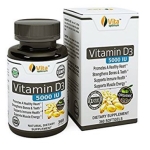
Vita Optimum sources pure vitamin D3 for their supplements from the highest-quality lanolin only. This product is perfect for those with allergies to the common preservatives, binders and fillers you’ll find in many other vitamin supplements. They don’t use soy, gluten, lactose, egg, peanuts, shellfish, tree or ground nuts in any of their products. Vita Optimum caters to everyone, but are the preferred vitamin D3 manufacturer with people who have thyroid problems and/or autoimmune disorders. With only one capsule required per day and 360 in each bottle, you’ll only need to order it once a year.
#3.Nutrigold Vitamin D3 5000 IU

This is another heavyweight contender when it comes to large single-dose softgels. Each capsule comes with 5000 IU of pure organic lanolin-derived D3, sourced from grass fed beef. Rather than using cheap vegetable oil as a base to hold the D3, Nutrigold instead uses quality organic olive oil to compliment digestion. Since D3 is fat-soluble and olive oil is loaded with rich healthy omega 3 and polyunsaturates, you can be sure this product offers superior absorption to many of its competitors. Each $15 bottle comes with nearly a year’s supply of daily doses (360 capsules). This is a completely allergen-free, non GMO, zero preservatives added and kosher product, that undergoes rigorous batch testing protocol before it lands in your cupboard or medicine cabinet.
#4.NatureWise Vitamin D3 5,000 IU

NatureWise is another great natural foods company that takes their company and their ingredients seriously. This vitamin D3 supplement contains biologically active D3, which is extracted presumably from sheep or bovine lanolin (though they don’t divulge this on the packaging). The only ingredients, aside from the 5000 IU of D3, are organic olive oil, water, glycerine, and all natural gelatin (for the softgel shell). This is another allergy-friendly product that contains no gluten, soy, corn, sugar, sweetner, or tree and ground nut oils. Their customer support number is proudly listed in the link above and they’ve received plenty of praise from current customers for their ability and willingness to answer any and all presales questions.
#5.Vitafusion Vitamin D3 Gummy Vitamins

These 2000 IU gummies from Vitafusion are definitely made with children in mind, since it’s often so hard to get them to swallow medicine and/or health food supplements. That doesn’t mean that parents and grand parents aren’t welcome to try them though! Flavors available include peach, blackberry and strawberry flavors. And there are several package sizes available starting at a 150 count and going up to a package of 750 (perfect for supplying two people for an entire year.) One drawback would have to be that this D3 supplement does contain some sugar (glucose and sucrose) but all the ingredients are still all-natural, with no lab-made preservatives or flavorings.
#6.Nature Made, Vitamin D3 2,000 I.U. Liquid Softgels

Nature Made always makes good healthful products. In fact, they were one of the very first companies to receive a USP (United States Pharmacopia) Certification when the new safe and health-conscious manufacturing and distribution standard for medicines, supplements and food additives was introduced. This 2,000 IU softgel definitely gets the job done, without putting too big a dent in your budget. Strangely enough, the one drawback to purchasing this product is that soybean and corn oil are used as a base for the liquid holding the D3 in the capsule, and artificial color is also added. If you don’t have any allergies to soy or corn, this wallet-friendly product is a great choice.
#7.Kirkland Signature Extra Strength Vitamin D3 2000 I.U. 600 Softgels

This D3 supplement from Kirkland is great for people whose blood levels of D3 are slightly low, or for folks who just want to make sure they’re getting enough in their diet. Though the label claims to be extra strength, each capsule only delivers 2000 IU; plenty more than the RDA for any age group, but less than some I’ve mentioned already. The D3 is extracted from lanolin and is of very high quality (they’re USP Certified). The price for 600 softgels is really low also, at just under $15. The one defining drawback is that Kirkland products are for the budget-minded consumer (they’re big at Costco) so they do use known allergens including soybean and corn oil, meaning you’ll need to avoid this one if you have a known allergy to any of the ingredients on their label.
#8.Seeking Health Liquid Vitamin D 3 – 2,000 IU per drop – Best Vitam D-3 Drops
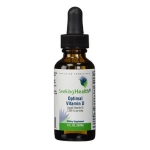
Seeking Health is one of a handful of trusted companies out there who make a dropper version of D3 for people who simply cannot stand pills and capsules. If you’re against the harming of animals for any reason, the 2000 IU per dropperful is made from lanolin that’s extracted from live sheep (Sheep are most common for this use (cows – i.e, bovine – are a close second.) One of the really attractive benefits of using Seeking Health Liquid Vitamin D3 over other products is the pennies-per-dose price: each bottle costs just under $20 before taxes and offers 900 doses – around 2 ½ year’s worth if taken once a day!
#9.Ddrops Baby 400 IU, Vitamin D – Best Vitamin D-3 Drops For Babies

An adult or teen would have to take over 50,000 IU of active vitamin D3 for weeks or months, to even come close to “over-dosing” and experiencing negative side effects. However, infants are much more sensitive to everything, which is why their recommended dose is half that of an adult or teen. These 400 IU Baby D Drops are perfect for making sure baby, who probably doesn’t spend much time in the sun, has enough vitamin D to help support their growth and well-being. This pediatrician-recommended product makes it easy to make sure you’re giving baby “just enough” D3 without overdoing it.
#10.Carlson Labs Carlson Laboratories Super Daily D3 for Baby 400IU Supplement
This is another infant D3 formula that offers the recommended dose of 400 IU per drop. It also gives you a year’s supply of daily doses, as opposed to only 6 months offered by the Baby D Drops. The main issue that I have with this product is that despite being one of the highest-quality forms of D3 on the market, and that it contains no allergens or laboratory ingredients – Carlson refuses to include a removable dropper with the package! It’s built in to the squeeze bottle design and you do have to be more careful so as not to double-dose your infant. If you don’t have shaky hands this product is a great value at under $10 for a year’s supply for baby.
Conclusion
I hope I’ve gotten the point across to you about the importance of getting enough vitamin D into your body every day.
Let’s recap a few of the more important points already discussed:
• Vitamin D is converted to calcitriol in the body by the kidneys.
• Calcitriol is responsible for turning on (and off) at least 200 different genetic functions in the body.
• Some of those more important function include switching the white cells of our immune system on to kill bacterial and viral invasion in the body, and switching them off (to prevent autoimmune problems).
• Calcitriol also tells our gut when to absorb critical nutrients like calcium, phosphorus, potassium, magnesium and iron – all of which are essential to bone and heart health.
• Children and adults need at least 600 IU every day for optimal health, but a dose of 2000 – 6,000 IU is a sure way to ensure you don’t become deficient.
• Pregnant and breast-feeding mothers need at least 800 IU every day, but doctors often recommend up to 10,000 IU to make sure both baby and mother are protected from deficiencies.
• People who don’t get enough vitamin D don’t live as long (source) and are more likely to develop certain cancers like prostate, breast, pancreatic and colorectal cancers (source).
• Few cases outside of laboratory studies have ever been reported with regard to hypervitaminosis D (ie., overdosing), making the dangers of not getting enough far more of a health concern.
If you fit into any of the risk categories mentioned in this article, getting extra vitamin D is just as important as getting enough vitamin C in your diet.
I personally take 5,000 IU every day. If you’re trying to be ultra-safe, aim for supplementation with up to 4,000 IU – considered to be the safe upper limit by many health organizations all over the world.

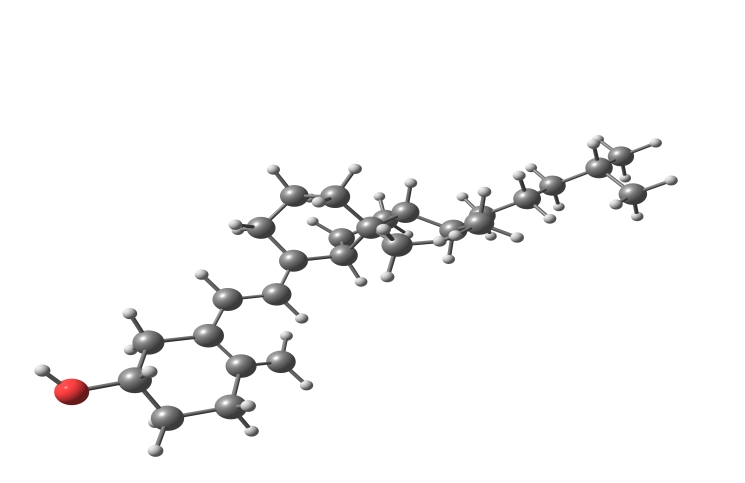
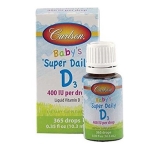



I am always out in the sun trying to absorb as much Vitamin D as possible. A doctor recently suggested supplements, so stumbling across this article was timely! With so many Vitamin D supplements on the market, is there anything I should look for before buying one? I want to be the right choice.